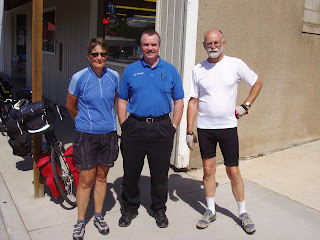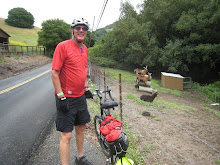June 19 White Bird 65 miles 5:15 riding
June 20 Kooskia 50 miles 5:23 riding
In spite of the anxiety I expressed at my last posting, getting to White Bird Summit turned out to be a piece of cake.
We followed the Salmon River all the way to White Bird. We crossed the 45th Parallel, halfway to the North Pole. The North Pole seems closer than Boston. We passed a compound where some people are waiting for the end of the world.

Just past Lucille, an old guy in a torn t-shirt waved us over to point out his friend in the river. The friend was using scuba gear to work an underwater dredge to extract gold. Watching this heavy work in icy water, I asked if the operator makes a living at this. "He doesn't really have to. He's on Social Security disability." was the explanation. Our tax dollars at work. The guy who waved us over is a local miner. He inherited a claim from his father. He's researching whether the claim antedates Idaho statehood. If it does, he says, he owns the bed of the Salmon River up to the highwater mark. I asked what he could do with the bed of the Salmon River.

He's not sure, maybe trade it to the State for something else.
It was 102 when we reached White Bird. It's just a bend in the river deep in a canyon. It has the historical importance of being where the cavalry commenced the war against the Nez Perce Indians, but that translates in economic importance into one motel whose best days are behind it, one bar, and one cafe. My expedition into the bar convinced me it would be a good place for a stranger to be on his best behavior in.
New Highway 95 bypassed White Bird (on a bridge soaring about 200 feet above actually) leaving old Highway 95 to wind back and forth across the canyon wall in at least a dozen switchbacks. We got started at 5:45 to beat the heat. In three hours on the road, we saw exactly two cars. 6650 turns of the crank later (according to my fancy odometer), we were at the top. We ran into Ed along the way, riding in the other direction. Ed is going coast to coast in annual segments. He is in remission from cancer. His advice is "Live for today." There's a lodge at White Bird Summit. We stopped to beg for a couple of Cokes and chatted with the proprietor. I asked about the stack of strange-looking items stored in a barn. She paints natural rock surfaces with some latex material, then peels off the dried latex to use as a mold. When a museum wants real-looking rock surface for a diorama, they call her and choose the model they need.
Do not stay at the Bates Motel. Do not stay at the campground at Kooskia, Idaho.
Roy ordered a baked potato with his dinner. When we all gaped at the watermelon-sized potato, the waitress remarked, "You're in Idaho now."



















